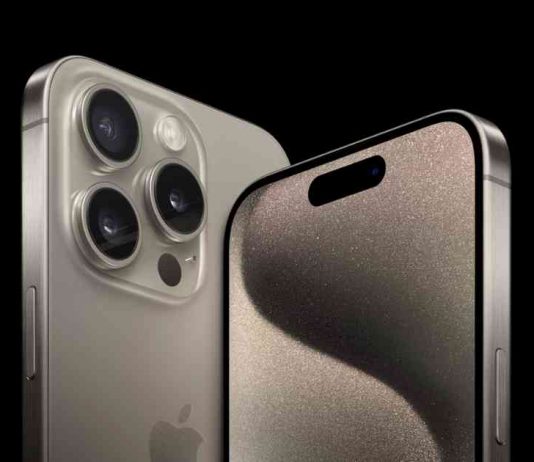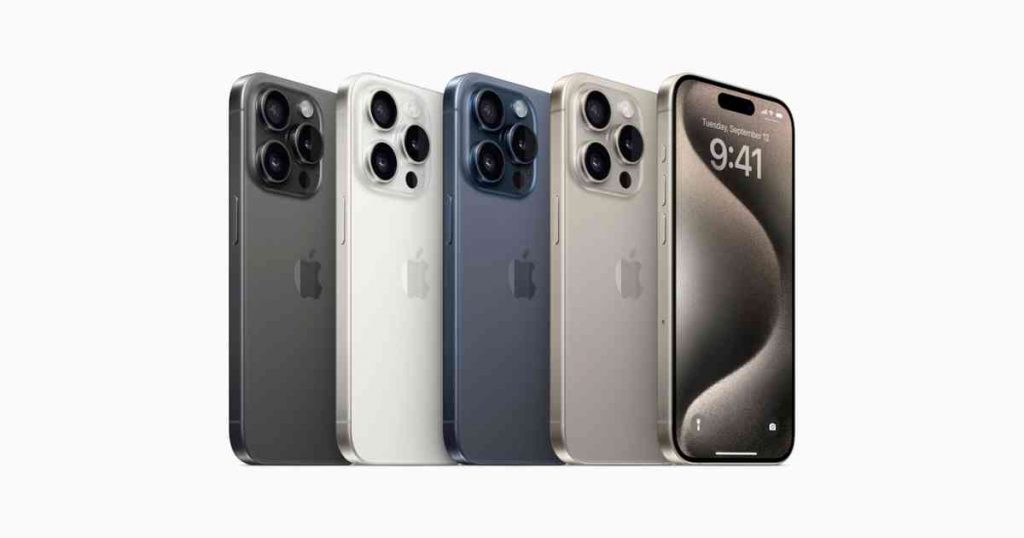Apple unveiled its latest iPhone 15 series at the recent Wonderlust event. While some of the features were already speculated upon, the official announcement did have its share of surprises. Let’s break down the key differences among the iPhone 15, iPhone 15 Plus, iPhone 15 Pro, and iPhone 15 Pro Max.
Contents
Chip A17 Pro vs. A16 Bionic
As we already know, Apple has always been at the forefront of chip innovation. This year, the iPhone 15 series introduces two distinct chips: the A17 Pro and the A16 Bionic.
A17 Pro:
The A17 Pro chip, exclusive to the iPhone 15 Pro and Pro Max, developed under a 3nm process, this chip is designed to push the boundaries of what a smartphone can do.
- CPU: The A17 Pro features a new 6-core CPU that is 10% faster than its predecessor in the A16 Bionic. This means quicker app launches, smoother multitasking, and an overall snappier user experience.
- GPU: When it comes to graphics, the A17 Pro is no slouch either. Its 6-core GPU is 20% faster than the A16 Bionic, making it ideal for graphic-intensive tasks like gaming and video editing.
- Ray Tracing: One of the standout features is hardware-supported ray tracing. This is a game-changer for mobile gaming, offering console-level graphics right on your smartphone.
- AV1 Decoder: The chip also includes an AV1 decoder, aimed at those who use their mobile devices for video streaming. This ensures a smoother, more efficient video playback experience.
A16 Bionic:
The A16 Bionic chip, found in the iPhone 15 and 15 Plus, is no underdog. It was first introduced in 2022 and continues to be a robust choice for most users.
- CPU: The chip features a 6-core CPU, with 2 performance cores and 4 efficiency cores. While it may not be as fast as the A17 Pro, it still offers a highly responsive user experience.
- GPU: The A16 Bionic comes with a 5-core GPU, which, although not as fast as the A17 Pro, is more than capable of handling most graphic-intensive tasks with ease.
- Neural Engine: Both chips feature a 16-core Neural Engine, but the A17 Pro’s is twice as fast. This is crucial for tasks that require machine learning, like facial recognition and augmented reality.
Aluminum vs. Titanium
When it comes to the iPhone 15 series, Apple has taken a dual approach in material selection, offering both aluminum and titanium options.
The Aluminum Allure: iPhone 15 and iPhone 15 Plus:
The standard iPhone 15 and iPhone 15 Plus models are crafted from aluminum, a material known for its lightweight and durable properties. The aluminum casing is complemented by a tinted glass back cover, adding a touch of elegance to the overall design.
- Color Palette: These models come in a vibrant range of 5 colors —black, blue, green, yellow, and pink — giving you the freedom to express your personality.
- Sustainability: Apple has been increasingly focusing on sustainability, and the aluminum used in these models is often recycled, making it an eco-friendly choice.
- Affordability: Aluminum is generally less expensive than titanium, making these models more budget-friendly without compromising on quality.
The Titanium Titans: iPhone 15 Pro and iPhone 15 Pro Max:
For those seeking a more premium experience, the iPhone 15 Pro and Pro Max models are the epitome of luxury and strength, thanks to their titanium construction.
- Strength-to-Weight Ratio: According to Apple, the titanium alloy used has one of the highest strength-to-weight ratios of any metal. This makes the phone incredibly robust yet lightweight.
- Sophisticated Colors: These models are available in four refined shades — black titanium, white titanium, blue titanium, and natural titanium — each exuding a sense of sophistication.
- Heat Dissipation: Interestingly, these models feature a new internal structure made from recycled aluminum. This not only aids in heat dissipation but also makes it easier to replace the back cover, which is made of textured matte glass.
- Premium Feel: Titanium gives the phone a more luxurious feel, making it a top choice for those who are after both aesthetics and performance.
Camera Capabilities
When it comes to capturing life’s moments, the iPhone 15 series doesn’t just step up the game; it redefines it. Let’s zoom into the camera capabilities that set each model apart.
iPhone 15 and iPhone 15 Plus:
Both the iPhone 15 and iPhone 15 Plus sport a primary sensor of 48 megapixels. These models also feature a 12 MP ultra-wide lens with a 120° field of view. The telephoto lens is a 2x 12 MP sensor, thanks to the Quad Pixel technology. This array allows for a variety of shooting modes, from capturing wide landscapes to zooming into distant objects.
iPhone 15 Pro and iPhone Pro Max:
The iPhone 15 Pro and Pro Max also come with a 48 MP primary sensor but with a twist. These models introduce second-generation sensor-shift optical image stabilization, ensuring that your shots are always crisp and clear. The ultra-wide lens is also 12 MP but comes with 100% Focus Pixels, making it faster and more accurate.
One of the standout features of the iPhone 15 Pro models is the ability to record spatial video. This feature allows for a more immersive viewing experience when played back on Apple Vision Pro.
The iPhone 15 Pro Max takes it a notch higher with a unique 5x telephoto lens at 120 millimeters. This lens is perfect for capturing detailed shots from a distance, whether it’s a bird in flight or a player scoring a goal on the soccer field.
Zoom Capabilities:
- Standard Models: Optical zoom of 2x; digital zoom up to 10x.
- Pro Models: The Pro offers a 3x optical zoom and up to 15x digital zoom, while the Pro Max goes all out with a 5x optical zoom and a staggering 25x digital zoom.
Storage Options
- iPhone 15 and iPhone 15 Plus: These models continue the tradition of offering three storage options — 128 GB, 256 GB, and 512 GB. While these may seem like standard offerings, it’s essential to remember that Apple’s efficient iOS allows you to make the most of this space. Whether you’re a casual user who mainly uses their phone for social media and photos or a more demanding user who needs space for various apps and files, there’s an option for you.
- iPhone 15 Pro: This model starts at 128 GB, which is more than enough for the average user. However, for those who are into professional photography, video editing, or heavy gaming, the 256 GB and 1 TB options are a godsend. The 1 TB variant, in particular, is aimed at professionals who require immense storage for 4K videos, high-resolution photos, and other large files.
- iPhone 15 Pro Max: Here’s where things get interesting. The Pro Max model starts at a whopping 256 GB, skipping the 128 GB option altogether. This is a clear indication that Apple is targeting users who need more from their smartphones — be it for professional photography, 4K video recording, or extensive app usage. And yes, the 1 TB option is also available for those who want to go all out.
The Game-Changing Action Button
When it comes to innovation, Apple never disappoints. This year, the tech giant has introduced a feature that’s set to redefine how we interact with our smartphones: the Action Button. Exclusive to the iPhone 15 Pro and Pro Max models, this button is a game-changer, and here’s why.
- Seamless Ecosystem Integration: The Action Button is not a standalone innovation but a feature that has been successfully implemented in the Apple Watch Ultra. By introducing it in the iPhone 15 Pro series, Apple is creating a more unified and seamless user experience across its ecosystem.
- Beyond the Mute Switch: The traditional mute switch on iPhones has always had a single function — to mute or unmute the device. The Action Button replaces this but offers a plethora of functionalities.
- User-Centric Design: Apple has designed the Action Button with the user in mind. You can customize it to perform tasks that you frequently use, like snapping a quick photo or turning on the flashlight.
- One Button, Multiple Actions: The Action Button’s compatibility with Apple’s Shortcuts app is a game-changer. You can program the button to perform complex tasks that would usually require navigating through multiple apps or settings.
- Automate Your Life: Imagine pressing the Action Button to send a preset text, turn on your smart home devices, and even start your morning coffee maker. The integration with Shortcuts makes this possible.
- Inclusive Design: The Action Button can be a powerful tool for users with limited mobility or other accessibility needs. By programming the button for essential tasks, the iPhone becomes more accessible than ever.
- Personalized User Experience: The ability to customize the Action Button means that it can be tailored to meet individual needs, making technology more inclusive.
By allowing for such a high degree of customization and utility, the Action Button enhances the overall user experience, making it more intuitive and user-friendly.
USB-C Implementation
The shift from the Lightning port to USB-C across all iPhone 15 models is a significant move by Apple, but the implementation isn’t uniform across the board.
If you’re eyeing the iPhone 15 or iPhone 15 Plus, prepare for a bit of a disappointment. These models are limited to USB 2.0 speeds, capping data transfer rates at a mere 480 Mb/s. Essentially, you’re getting the same performance as you would with the old Lightning cable and connector. While the USB-C port may appear modern, the underlying technology is somewhat dated, leaving these models lagging in the fast-paced world of data transfer.
On the flip side, the iPhone 15 Pro and Pro Max are in a league of their own. These models come with a USB 3 controller, part of the A17 Pro chip, allowing for data transfer speeds of up to 10 Gb/s with a compatible cable. While it’s not the rumored Thunderbolt 4 support, it’s undeniably a drastic improvement. This is particularly beneficial for professionals who use their iPhones for high-quality photo or video work. The faster data transfer can be a real time-saver when you’re working on tight deadlines.
The divergent USB-C implementations raise questions about Apple’s strategy. Is this a calculated move to push consumers toward the more expensive Pro models, or is it a missed opportunity to standardize high-speed data transfer across all models? Either way, it’s a point to ponder before making your purchase.
Size and Weight
When it comes to the iPhone 15 series, size does matter, but not in the way you might think. While the screen sizes across the models are consistent—6.1 inches for the iPhone 15 and 15 Pro, and 6.7 inches for the iPhone 15 Plus and 15 Pro Max—the dimensions and weight tell a different story.
- iPhone 15: Height: 14.76 cm, Width: 7.16 cm, Thickness: 0.78 cm, Weight: 171 grams
- iPhone 15 Plus: Height: 16.09 cm, Width: 7.78 cm, Thickness: 0.78 cm, Weight: 201 grams
- iPhone 15 Pro: Height: 14.66 cm, Width: 7.06 cm, Thickness: 0.83 cm, Weight: 187 grams
- iPhone 15 Pro Max: Height: 15.99 cm, Width: 7.67 cm, Thickness: 0.83 cm, Weight: 221 grams
Though the differences in dimensions may seem minuscule, they can significantly impact the user experience. For instance, the Pro models are slightly thicker at 0.83 cm compared to the standard models at 0.78 cm. This extra thickness could be attributed to the advanced hardware packed into the Pro models, such as the A17 Pro chip and additional camera capabilities.
The weight also varies among the models. The iPhone 15 Pro Max, at 221 grams, is the heaviest, likely due to its titanium construction and advanced features. On the other hand, the iPhone 15, the lightest at 171 grams, offers a more comfortable hold for extended periods.
Interestingly, despite having the same screen sizes, the Pro and Pro Max models boast the slimmest edges in the market. This design choice not only adds to the aesthetic appeal but also allows for a more immersive viewing experience.
ProMotion: Still a Pro Exclusive
Apple’s ProMotion, which was already exclusive to the Pro and Pro Max models in the previous iPhone series, continues to be a standout feature in the iPhone 15 Pro and Pro Max.
ProMotion is Apple’s proprietary technology that allows for an adaptive refresh rate of up to 120 Hz. In simpler terms, it makes everything on your screen look smoother and more responsive. Whether you’re scrolling through your social media feed, playing a high-octane game, or watching a fast-paced action movie, ProMotion ensures that your experience is as fluid as it gets.
It reduces motion blur and offers a more responsive touch interface. For professionals who use their iPhones for tasks like video editing or 3D modeling, this feature can make a world of difference.
While the standard iPhone 15 and 15 Plus models come with OLED Super Retina Display XDR, they are likely locked at a 60 Hz refresh rate. This means that while the display quality is excellent, it won’t offer the same fluidity and responsiveness as the Pro models. For the average user, this might not be a deal-breaker, but for those who crave that extra layer of smoothness, the Pro models are the way to go.
iPhone Series 15 Price
- iPhone 15: Starts at $799 with 128GB of storage. If you’re looking to upgrade, 256GB will cost you an additional $100, making it $899. The maximum 512GB configuration is priced at $1,099.
- iPhone 15 Plus: Starts at $899 for the 128GB variant. The 256GB and 512GB configurations are priced at $999 and $1,199, respectively.
- iPhone 15 Pro: Starts at $999 with 128GB of storage. The 256GB model is priced at $1,099, the 512GB at $1,299, and the 1TB variant will set you back a whopping $1,499.
- iPhone 15 Pro Max: Starts at $1,199 with a larger 256GB of storage. The 1TB variant is priced at $1,599.
All models will be available for preorder starting September 15th and are set to ship a week later on September 22nd.




